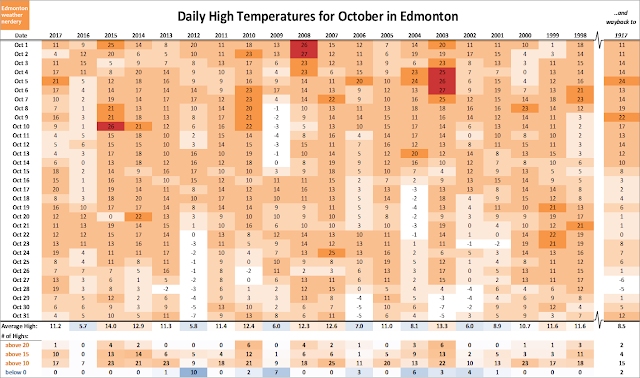High Temperatures
We started November with a string of High temperatures that were right at the bottom of what we've seen since 1996, and it included 5 recent records. November 3rd and 8th in particular were almost 15°C below the average, although they were still a few degrees above the all-time historic records.
That cold weather lasted about 3 weeks before temperatures warmed up, and then for the end of the month we were about 5°C or 6°C above average.
Our average High of -3.5°C was about the same as 2014 and 2012, although those months both started warm and ended cold. The coldest recent November was 2006, with an average High of -6°C. 2006 had 7 days above freezing, this year we had 10, and the average is 18, so we were definitely on the cold-side of things.
As an aside, November of 1917 (on the right side of this table) was really, really warm. It's average High of 10.6°C was 5°C warmer than anything we've seen in the last 20 years, and it was 14°C warmer than November 2017.
Low Temperatures
As usual, the Low temperatures followed a similar pattern to the Highs. We had the same cold start to the month, which was followed by the above-average end.
2017 was one of the rare years where November didn't have any Lows above freezing. In recent history that had also happened in 2006, 2003 and 2000.
2017 also didn't have any Lows below -25°C or -20°C though, although we did come close with -18.5°C and -18.7°C on the 20th and 21st, and a really early -18.0°C on the 4th.
Again on the right side of the table we can see that 1917 was warm, with an average Low of -2.1°C. That matches 2016 which was the warmest year here, and it was 8°C warmer than November 2017.
1917 & 2017
This is a comparison of 1917 and 2017. We first looked at this style of chart here, and it compares the average temperature (of the Highs and the Lows) for each month of the year to the average temperature from the 20th century.
For most of 2017 we've been a few degrees above the 20th century reference, with the exception of a slightly cool March & April, and now a November that was about 4°C below.
1917 spent most of the year a few degrees below the 20th century average, before things exploded in November, which was 8.3°C above the 20th century average. November 1917 was actually the warmest November on record in Edmonton, while 2017 was in 119th spot out of 137.
In December of 1917 the weather took a turn though, which we can see from the big, blue bar. At 11.3°C below the 20th century average that was actually the 3rd coldest December on record.
December Highs
As we head into December, things can be pretty random.
Some years like 2010 have no Highs above freezing, and others have 15, or 18, or even 22 like in 1999. The average number of days above freezing is 10 though, and 3 days above 5°C. On the colder side of things, about one quarter of the time we have had some Highs below -20°C in December.
December Lows
For Low temperatures we can probably expect to spend most of the month below -10°C, and since 1998 the only Decembers that didn't have any Lows below -20°C were 2011 and 2002.
Precipitation
Here we have the total precipitation - snow and rain - for the month. The International Airport recorded 20mm of precipitation, which is right on the average, and just a bit below the 17mm that were recorded last year.
Blatchford recorded 12mm, which makes this the 5th month in the row where Blatchford's precipitation was notably below the International's. So far for 2017 the International has recorded 487mm compared to 373mm at Blatchford.
Snowfall
In terms of snowfall the International was also right on the average this November, with 19cm. And that is a typical amount of snowfall for most of the winter months, with the exception of February which has usually been a bit lower.
Snowdepth
And finally for today, here we have snowdepth. This year we got an early start on Halloween, and that has carried us through November.
When we break that down into averages & quartiles, this November the International has been a bit above the 75th percentile, although the warmspell at the end of the month melted some of that off.
Environment Canada has also started tracking snowdepth at Blatchford again, after a gap of several years. It is shown here as the dotted green line, and it's a few cm below the International. Over the winter we'll hopefully be able to see how the two compare.
November 2017 Summary
Cold start; warm end; average precipitation; a bit more snow on the ground than normal.






















